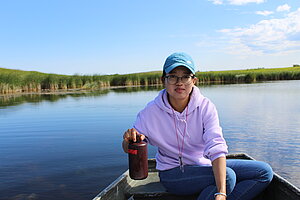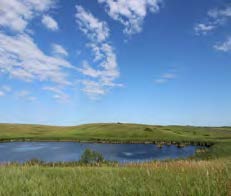Understanding intra-lake seasonal and spatial variability in shallow prairie lake diatom communities: implications for paleolimnological studies

Kui Hu is a Ph.D. student in the Environmental Sciences and Conservation Program and Department of Biological Sciences at North Dakota State University (NDSU). She holds a Bachelor’s Degree of Science in Geography and a Master’s Degree in Physical Geography from Yunnan Normal University, China. She is currently working with Dr. Jon Sweetman on detecting the freshwater community changes and ecosystem resilience in response to climatic change (especially extreme drought events) through applying limnological and paleolimnological methods (i.e. diatoms, cladoceran, isotopes and geochemical proxies).
Understanding intra-lake seasonal and spatial variability in shallow prairie lake diatom communities: implications for paleolimnological studies
Prairie Pothole wetlands play a significant role in providing important freshwater resources and vital ecosystem services for socio-economic development in North Dakota. The climate in this area is highly variable both annually and seasonally, which has markedly influenced wetland ecosystems. The seasonality of physical, chemical, and biological water variables is a major characteristic of temperate polymictic lakes. Understanding intra-lake seasonal and spatial variability in shallow prairie lake diatom communities will be important for obtaining improved insight about long-term changes in wetlands ecosystems. In this project, we will use ice-free monthly survey data (water chemistry and diatom) from two adjacent, but hydrological different lakes P1 and P8, located in the Cottonwood Lake Study Area, North Dakota. The aims of this research are to: (1) investigate the patterns of seasonal succession within both lakes, (2) evaluate the main environmental variables that affect diatom community seasonal and spatial changes, as well as (3) evaluate patterns of spatial variability of diatom communities within a lake.
Project Objectives:
This research is focused on investigating intra-lake seasonal and spatial variability in shallow prairie lake diatom communities. Specific objectives include: 1) Investigate the patterns of seasonal succession of diatom communities within two adjacent prairie lakes (P1 and P8). 2) Evaluate the main environmental variables that affect the diatom community throughout the seasonal and within the lakes (spatial variability). 3) Evaluate the similarity of diatom communities and diversity within a lake.
Progress:
Our results showed that diatom communities were predominated by Cyclotella meneghiniana, except in June, which was dominated by Campylodiscus bicostatus in prairie lake T1/P1. Diatom community was dominated by Nitzschia palea on May, shift to Nitzschia amphibia on June. The rest months were dominated by Cocconeis placentula in lake P8. There is a significant seasonal succession across all the 4 sites at P8. There is a high similarity within pond diatom communities in prairie lake P8, whereas lake P1/T1 communities are more variable, which may due to the relative higher nutrient and more diverse of habitats in P1. Ionic concentrations are the main factors that seem to drive diatoms changes in P1/T1, while nutrients and hydrology appear to be the main factor explaining the seasonal diatoms community changes in P8.
Significance:
The climate of the PPR is very dynamic and can fluctuate between extreme wet and dry periods in which periods of abundant precipitation can be followed by drought. To get better interpretation about how drought and flood influences the wetland biotic community, we have conducted one year of monthly monitoring survey. There are currently no studies examining how water chemistry and meteorological changes affect diatom community changes over a season in this research area. Understanding of both seasonal variability and within lake differences in diatom assemblages will help improve our interpretations of longer-term (inter-annual) changes using diatom records preserved in sediment cores (another component of my dissertation). A clear understanding about the dynamics of the Prairie Pothole wetland ecosystem in response to climate variability both at short time scale (within year) and long term (hundred years) will help policy and decision makers propose appropriate management strategies to face the changing climate of the future.
Conference/Seminar Presentations:
Kui H., D. M. Mushet, J. N. Sweetman. Talking, 2019 Great Plains Limnology Conference (GPLC 2019), 18th-20th Oct. 2019, Ames IA (Title: Understanding intra-lake seasonal and spatial variability in shallow prairie lake diatom communities: implications for paleolimnological studies)


Jon Sweetman
Biological Sciences
Office: Stevens 211A
Telephone: 701-231-8991
Email: jon.sweetman@ndsu.edu


